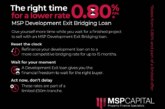
© Phushutter/ Adobe Stock
Neil Leitch, Managing Director of Development Finance, Hampshire Trust Bank explains why SME developers should be taking a closer look at revolving credit facilities
With the new government reaffirming its ambition to deliver 1.5 million homes during this parliament, all eyes are on how that target can be achieved.
While planning reform may help, the delivery of those homes will depend on developers bringing forward the schemes – and that increasingly means SME developers.
SME developers are central to future housing delivery. Whether it’s unlocking brownfield sites, progressing complex land, or building in areas of genuine local demand, they are the ones leading the way. But as developers scale their operations, the question is whether their funding approach is still fit for purpose.
The challenge with project-by-project funding
Traditional development finance has worked for many years. It provides clarity, control, and a predictable funding structure. However, for developers managing several sites or aiming to scale their operations, securing finance for each new project individually can become a bottleneck.
Each project requires revisiting the entire cycle of securing finance: legal agreements, valuations, due diligence, and credit processes. This takes up valuable time and slows progress, particularly when faced with rising construction costs and common planning delays. There is a lot of merit in an SME developer having the certainty of a fully funded facility but as they grow, they are less likely to want to fund and build an increasing number of houses, without having some certainty on sales. Once that view is taken, revolving credit facilities (RCFs) become an increasingly attractive option.
How a revolving credit facility can help
An RCF is a flexible, pre-arranged funding line that developers can draw from as needed and repay as they progress with their projects. While traditionally seen as a tool for larger corporations, RCFs are becoming more common in the large SME and small corporate development space.
Instead of applying for separate loans for each site, developers can use a single, tailored facility that provides the flexibility to support multiple projects. The developer only pays interest on the funds drawn, rather than the entire facility, helping improve cash flow management and reducing administrative burden.
It also allows developers to respond quickly to new opportunities. Sites can be progressed without waiting for a new facility to be arranged, helping maintain momentum across the business.
For example, HTB recently structured a £25 million revolving credit facility for a regional developer building over 240 homes across Yorkshire and Lincolnshire. The developer was managing sites at different stages with varied tenures and completion timelines. The facility was structured to provide phased drawdowns aligned with their build schedules, ensuring funding was available precisely when it was needed, without delay. This streamlined approach not only sped up their project timelines but also reduced the time spent on securing new funding for each scheme.
When it’s a good fit
Revolving facilities are ideal for developers managing multiple live projects or those with a defined pipeline of sites. The facility must be structured to reflect how the business operates.
A key consideration is whether project timelines and cash flows are predictable. For developers managing several live projects, each with its own set of requirements, a revolving facility can provide much-needed flexibility. This type of facility is perfect for developers taking on new opportunities and needing capital at different stages of each project.
However, an RCF is not a one-size-fits-all solution. For smaller developers or those working with longer gaps between projects, more traditional finance might still be the better option. Understanding your pipeline, capital needs, and how funds will flow across projects is essential when considering an RCF.
These facilities must be structured properly. Drawdown schedules, repayments, and facility terms must be tailored to the developer’s business model, ensuring alignment with construction schedules, cash flow, and project milestones.
The importance of the developer-lender relationship
For an RCF to be effective, it’s crucial to work with a lender who understands the specifics of development finance and can tailor the facility to the unique needs of the developer. An RCF isn’t simply a financial product – it’s a tool to support long-term business growth.
At HTB, we take a relationship-driven approach, working closely with developers to structure revolving credit facilities that align with their business model and future growth ambitions. By partnering with a lender who truly understands how a developer works, it’s possible to create a facility that is customised to the developer’s needs – ensuring it’s not only effective but also easy to manage.
Unlocking your potential for growth
As developers look to scale, managing multiple projects without the burden of applying for separate loans each time becomes a key advantage. An RCF provides a flexible, efficient solution to support growth, allowing developers to fund progress without the added complexity of traditional finance.
For developers with a strong pipeline and track record, an RCF offers the flexibility needed to maintain momentum, adjust quickly to changes, and grow the business at pace. With the right lender, RCFs are not just a financing tool – they are a way to help you scale confidently and efficiently, reducing the burden of administrative tasks and ensuring that your capital is used where it’s needed most.
For more information on development finance visit Development Finance | Hampshire Trust Bank (HTB).




